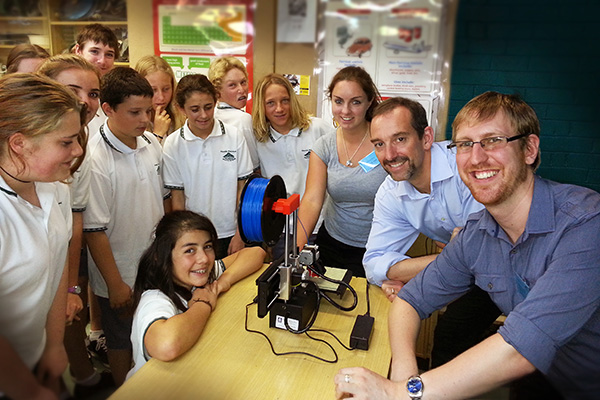October 29, 2014
Outreach program puts smiles on teachers’ faces at Ulladulla
A university outreach program has ensured that Ulladulla High School is set to join in the engineering and medical revolution taking place through the use of 3D printers.

Associate Professor Marc in het Panhuis (2nd from right) with and Reece Gately (1st from right),Holly Warren (3rd from right) and classmates with the donated 3D printer at Ulladulla High School. Photo: Joshua Westerway.
A high-end user of 3D printers, in the at UOW has donated a 3D printer to the South Coast school.
Together with two of his PhD students (Reece Gately and Holly Warren), the UOW team has provided training to students in using the printer and the teachers (Joshua Westerway and Andrew Lake) who will be incorporating it into the curriculum through the school’s design classes.
The high school has already been training the students in Computer Aided Design (CAD) program which prepared them to start 3D printing their projects.
“I have been working with the school during this year to provide staff and students with ideas and projects how to put what they teach into practice and also showing them where it can lead in terms of research,” Professor in het Panhuis said.
Professor in het Panhuis is partnered with Ulladulla High School through Scientists and Mathematicians in Schools. This is a national program that creates and supports long-term partnership between teachers and scientists. It is supported by the Australian Government Department of Education through the Maths and Science Participation Program and the Making Career Connections initiative.
“My research activities are funded through the Federal Government (Australian Research Council) and I strongly believe that it is my duty to give back to the community by engaging with, and exciting the next generation of young scientists,” Professor in het Panhuis said.
“Therefore I made a specific request to the Scientist and Mathematicians in Schools administrator to be linked with a high school in a regional/rural area, as I am aware of their problems in partnering with scientists.
“It’s amazing to see how much difference this donation is making to the school. You can see the smiles on the teachers’ faces.”
3D printing is an integral part of Professor in het Panhuis’ research activities and that of the on the Innovation Campus in which he is a Chief Investigator. For example, his own team is using a similar 3D printer to build a robotic prosthetic hand.
Meanwhile, a new eBook, , released recently at UOW, tells the story of this impending revolution in medicine that will involve the ability to re-grow and repair human tissue including bone, cartilage, muscle and nerves, all through a digital fabrication method called 3D BioPrinting. 3D BioPrinting is being enabled by a convergence of several revolutionary scientific advances including 3D printing, tissue engineering and biomaterials, which can seamlessly integrate into the body.